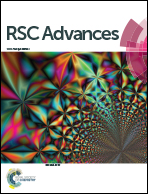Water-soluble amino(ethanesulfonate) and [bis(ethanesulfonate)] anthracenes as fluorescent photoinduced electron transfer (PET) pH indicators and Fe3+ chemosensors†
Abstract
Two novel water-soluble anthracene-based fluorescent indicators appended with amino(ethanesulfonate) groups were designed and synthesised. A monoethanesulfonated or diethanesulfonate ligand is located in the proximity of a tertiary amino moiety separated by a methylene spacer at the 9-position of an anthracene fluorophore. The molecular structure of the monoethanesulfonated species was determined by single crystal X-ray diffraction. The molecules were studied by UV-visible absorption and fluorescence spectroscopy in water as molecular probes for protons and cations. The anthracene probes function according to a photoinduced electron transfer (PET) mechanism based on a ‘fluorophore–spacer–receptor’ format resulting in blue fluorescence on protonation. The excited state pK*a values were evaluated to be 5.7 and 7.4, respectively, for the di- and monoethanesulfonated anthracenes at a constant ionic strength of 0.1 M NaCl. The monoethanesulfonated indicator exhibits a high fluorescence quantum yield of 0.62 in acidic solution, and an enhancement factor (EF) of 9, while the diethanesulfonated indicator has a more modest fluorescence quantum yield of 0.17 and an EF of 2.4. Under acidic conditions both indicators are susceptible to selective quenching of the fluorescence by Fe3+ with linear responses between 0.6–8.9 mM and 0.3–5.0 mM Fe3+ for the diethanesulfonated and monoethanesulfonated anthracenes, respectively. The lack of a vertex in the Job's plots indicates no metal–ligand complexation suggesting the fluorescence quenching may be due to an inner filter effect from Fe3+ absorbance.
![Graphical abstract: Water-soluble amino(ethanesulfonate) and [bis(ethanesulfonate)] anthracenes as fluorescent photoinduced electron transfer (PET) pH indicators and Fe3+ chemosensors](/en/Image/Get?imageInfo.ImageType=GA&imageInfo.ImageIdentifier.ManuscriptID=C5RA22341E&imageInfo.ImageIdentifier.Year=2016)


 Please wait while we load your content...
Please wait while we load your content...